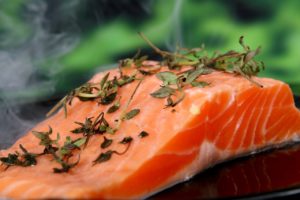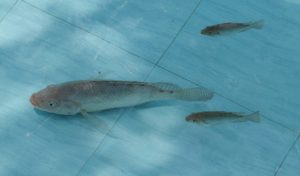Choosing Healthy Fish to Eat
With Summer here, we tend to eat more fish. Here is some information to help you make the best choices.
Shrimp
Shrimp that you purchase in the grocery store often comes from Asian farms that over use antibiotics. Shrimp is bathed in a sodium solution to make its meat juicier. Sulfites are used to prevent discoloration in the shrimp and some people react to the sulfites such as triggering a migraine.
Ask where you shrimp has come from and opt for domestic shrimp. The USA has stricter regulations regarding shrimp fishing and farming practices.
Choose North American wild caught shrimp, north shrimp, pink shrimp, spot pawns and white shrimp.
Salmon
Farming practices have improved but antibiotics are still a concern. Choose salmon that is wild caught from Alaska as there is no overfishing or contaminant risk. Wild caught Alaskan salmon will have a great omega 3 ratio. While vacuum sealed packs means more plastic waste, the benefit is that this flash freezing and packing process results in loss of very little nutrients.
If you eat canned salmon, look for wild sockeye.
If your salmon is being sold “fresh” in the winter months, it is probably a fraud.
Canned Tuna
Albacore canned tuna is high in mercury. For this reason, limit the amount you consume to no more than 3 cans per month. Smaller seafood such as scallops, sardines, oyster, shrimp and anchovies contain less mercury.
Larger fish will contain more mercury such as swordfish, grouper, marlin, orange roughly, and shark.
Choose skip hack tuna or light tuna in water. Avoid tuna that is in vegetable oil.
Beware: Some products may be mislabeled as tuna. Nearly 60% of the fish labeled tuna in the US is not tuna. 84% of white tuna sold at sushi places was a fish called escolar, which is associated with acute and serious digestive effects if you consume just a couple of ounces.
Tilapia
This fish does not contain any omega 3 essential fatty acids. Tilapia are fed a grain based diet when it has been farmed. Much of the tilapia comes from Asia where they may still use banned chemicals.
Choose tilapia that has come from the US, Canada, Ecuador or Peru.
Pollock
This fish you have most likely eaten if you eat breaded fish sticks and breaded fish in restaurants. It can also be found in imitation crab meat.
Choose Alaskan Pollock, also called Walleye Pollock or whitefish.
Buyer Beware!
Fish is often mislabeled and often when purchasing there is no information as to where the fish has come from. Ask at the fish counter or in the restaurant what country the fish is from, if it was wild caught or farmed. Sadly, many times the person will tell you he or she doesn’t know this information. I went to an expensive restaurant one time and asked where their salmon came from and he said jokingly “the water”. I never did get an answer. Just because you are paying a high price in an expensive restaurant, does not mean the quality of your fish is better.
Seafood from other countries is often factory farmed and the conditions are unhealthy. Often the fish are exposed to antibiotics and chemicals and are stored in bacteria-laden ice and may even be fed pig feces tainted with salmonella. The US only inspects about 2% of all the seafood that comes from abroad.
If you are pregnant, limit the amount of fish and seafood you consume and eat seafood that is the lowest in mercury such as wild salmon, sardines, mussels, rainbow trout and Atlantic mackerel. These fish are also rich in omega 3 essential fatty acids.
Other Fish
We tend to consume the same type of fish over and over such as salmon and canned tuna. There are other sustainable fish to choose from such as mullet and scup.
Bottom Line
Limit the amount of fish that you consume and do your homework prior to eating fish and seafood.
Some helpful sites to use include
www.eatthesefish.com This site shows a wide variety of fish that is safe to eat.
www.vitalchoice.com This is a good source to buy your salmon, canned salmon and other fish as well.
For my local CO readers: check out http://www.northeastseafood.com You can place an order and pick up at their Denver location. They send email announcements as to when in season seafood has arrived. Their wild salmon is from Alaska. Note that some companies may say that their salmon is wild but it is from the Pacific not Alaska.
If you are sick and tired of feeling sick, tired, fatigued, depressed, anxious and more and have given up hope then Karen’s simple, effective, individualized and sustainable approach may be what you need.
Karen Brennan, MSW, CNC, Board Certified in Holistic Nutrition and Herbalist is the author of Tru Foods Depression Free Nutrition Guide; How Food Supplements and herbs can be used to lift your mood and owner of Tru Foods Nutrition Services, LLC.
For more information visit www.trufoodsnutrition.com
Get her Food Swap Guide here to get started on your health journey today! Want more information, like her fb page here
As a nutrition professional, Karen does not treat, cure nor diagnose. This information is for educational purposes only.
Sources
http://seafood.edf.org/buying-fish-what-you-need-to-know#bmb=1
https://www.nrdc.org/stories/smart-seafood-buying-guide
http://articles.mercola.com/sites/articles/archive/2015/06/01/best-seafood.aspx
https://experiencelife.com/article/how-to-choose-seafood-thats-nutritious-sustainable-and-safe/
https://experiencelife.com/article/fish-smarts-for-pregnant-women/





Leave A Comment
You must be logged in to post a comment.